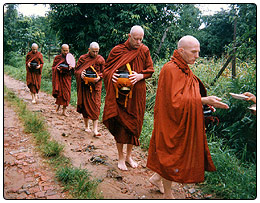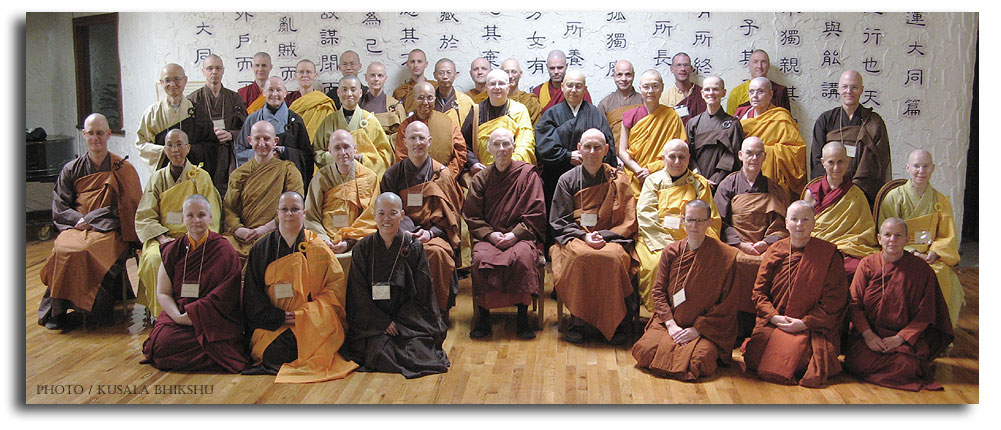Buddhist monasticism
The Buddhist monastic Sangha, who himself launched by the Order of monks Buddha ( Pali: bhikkhu, Sanskrit: bhikshu ) and nuns ( Pali: bhikkhuni, Sanskrit: bhikshuni ), represents a key element in the preservation and dissemination of the teaching ( Dhamma ) represents and, together with the laity the fourfold community. Buddhist nuns and monks live in celibacy.
General
First, there was bhikkhu and later also for Bhikkhuni Order. In the first years candidates were ordained only by the Buddha himself. Later - with fast growing community - he transferred the right to take monks, his disciples.
The Buddhist monks and nuns life is often ascetic than that in Christian Order. At first there was only houseless wandering monks who made their living on alms, and only later during the lifetime of the historical Buddha places of stay and accommodation were of wealthy supporters donated. Until then, huts were built only during the rainy season, which were torn down at the end.
In Buddhism, there are communities with very different lifestyles. It is of different " schools " is mentioned, probably because religious cleavage is viewed as a major offense. Even in Buddha's time there have been attempts and tendencies of the religious cleavage, but these were mostly politically motivated.
When the Order Entry is not life dedicated to God as in Christian order and filed a lifelong vows, but vows are for the time of the Order of stay and less than understood as a penance than of practice. Thus, the Order can leave at any time and are also joined him again. This freedom may be limited. So you go to Sri Lanka for life in the monastery, and the abandonment of the Order is very negative light. In contrast, in Thailand a two-year ordination for each young man is good form.
The great veneration which will be given to Buddhist monks, the person is less itself, but rather the respect for the Dhamma ( the Buddha's teachings, in Sanskrit: Dharma ), which the monk or the nun embodies / represents.
Today, fewer and fewer people are choosing in Asia for the monastic life. Were there 40 years ago at 1 million Tibetans still over 110,000 monks and nuns, now there are 2.7 million inhabitants, only 46,000, which are present here with the annexation by the People's Republic of China very specific historical and political reasons. Not as dramatic is the decline, which is also observed in other traditionally Buddhist countries. In contrast, the development of that store since the 20th century people from North America, Europe and Australia, the vows of monks and nuns. In some Asian countries (Taiwan, South Korea), an increasing importance of the Order of nuns should be noted. Even in countries where the nuns did not exist (Thailand ) or as was practically extinct, there have been efforts to revive it. In Sri Lanka, there are already in decades, a lively nuns with somewhat prominent members (eg, the late German -born Ayya Khema ).
The monks and nuns rules
In the Patimokkha ( Pali ) or Pratimoksha (Sanskrit ) both monks and nuns rules are set out, as that ceremonies are also hold in the religious life. They regulate all aspects of religious life. Fully ordained nuns ( Bikkhunis or Bikshunis ) have more rules as fully ordained monks. In addition to the life of the fully ordained there is also the possibility, as a novice ( Samanera, Samaneri ) enter the order and the way to go. The rules of the Order are designed democratically and based on the best interest of the majority and the line with the Buddha's teachings. The highest punishment is expulsion from the Order. A monk or a nun loses the ordination, when a " discharge end offense " or Parajika (see laicization ) were committed. The person returns through the misstep to the lay state and may in the life of a member of the Order be more. The Buddha was also given permission to finish the training as a monk or nun. If this is carried out properly, there is no error.
Mahayana ( Mahasanghikas and Mulasarvastavadins )
Main article: Pratimoksha
Mahayana Buddhism has two Mahayana sutras on which the two lines for the monastic tradition for monks and nuns relate: the pratimoksha Sutra Mahasamghikas and pratimoksha Sutra Mulasarvastavadins. Both lines go back to schools of Hinayana. The sutras are written in Sanskrit.
In this Sanskrit tradition differ in part to the rules of the Theravada tradition of Patimokkha. The core rules are but the same. It seems that rules have been modified or added. The ability to change was allowed by the Buddha when the Order decides by majority. The changes show up alone because bhikkhus ( Pali ) 227 vows and bhikshus (Sanskrit ) hold 253 vows. The country of origin of Buddhism is indeed India, but there are many rules in the Patimokkha due to climate change. For instance, the rule to be allowed to have no more than four pieces of clothing, no longer tenable for a monk or a nun in Japan at -5 ° C.
Theravada ( Theravada )
Main article: Patimokkha
In Theravada is still alive most accurate according to the Patimokkha rules. But here, in part concessions to modern life have already been made. This allows the handling of money not always be avoided. In the Theravada tradition, the monasteries are relatively autonomous, yet there are some higher-level hierarchies.
Clothing
The robe is called in the Theravada tradition, so in Pali, Ti cîvara and consists of three parts: Sanghati ( upper garment ), uttarâsanga (garment) and antaravâsaka ( undergarment ). In addition, monks may have a camisole ( msaka ) and a belt ( Kaya bandha ) possess; possibly even as many tissues ( low quality ) to cover parts of the body that are affected by skin diseases such as scabies. More than for personal use is necessary, monks should not have. Exceptions are allowed only if additional garments are shared with other monks and when the clothing is repaired or remade during the rainy season. Conversely, it should not monks naked or in clothes of laymen amongst people go ( outside the temple and / or in the presence of lay both shoulders must be covered in the rule).










